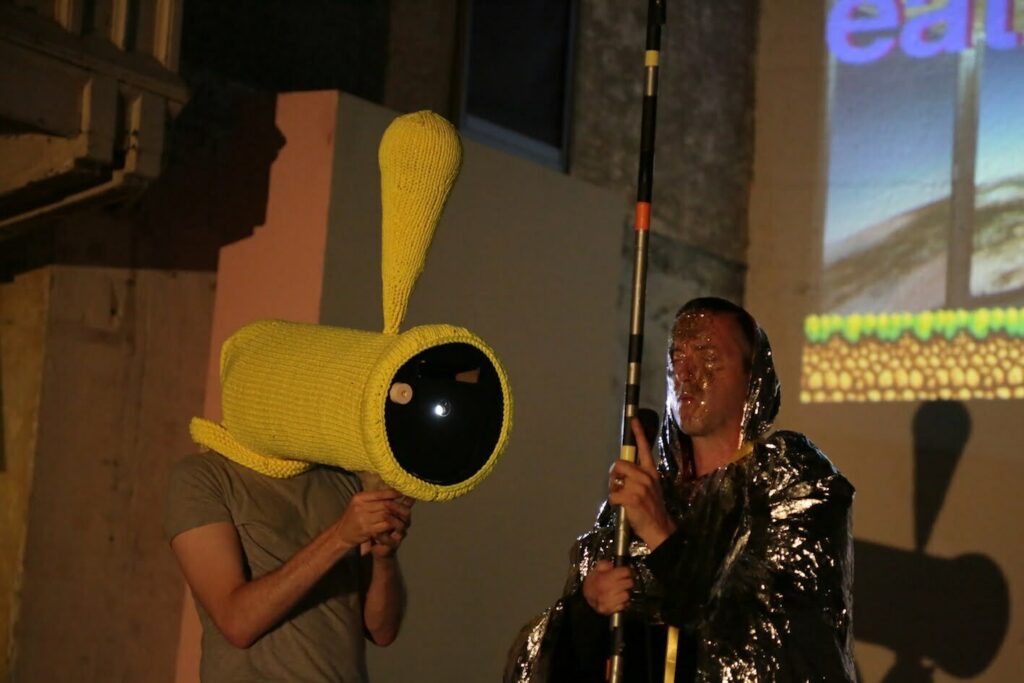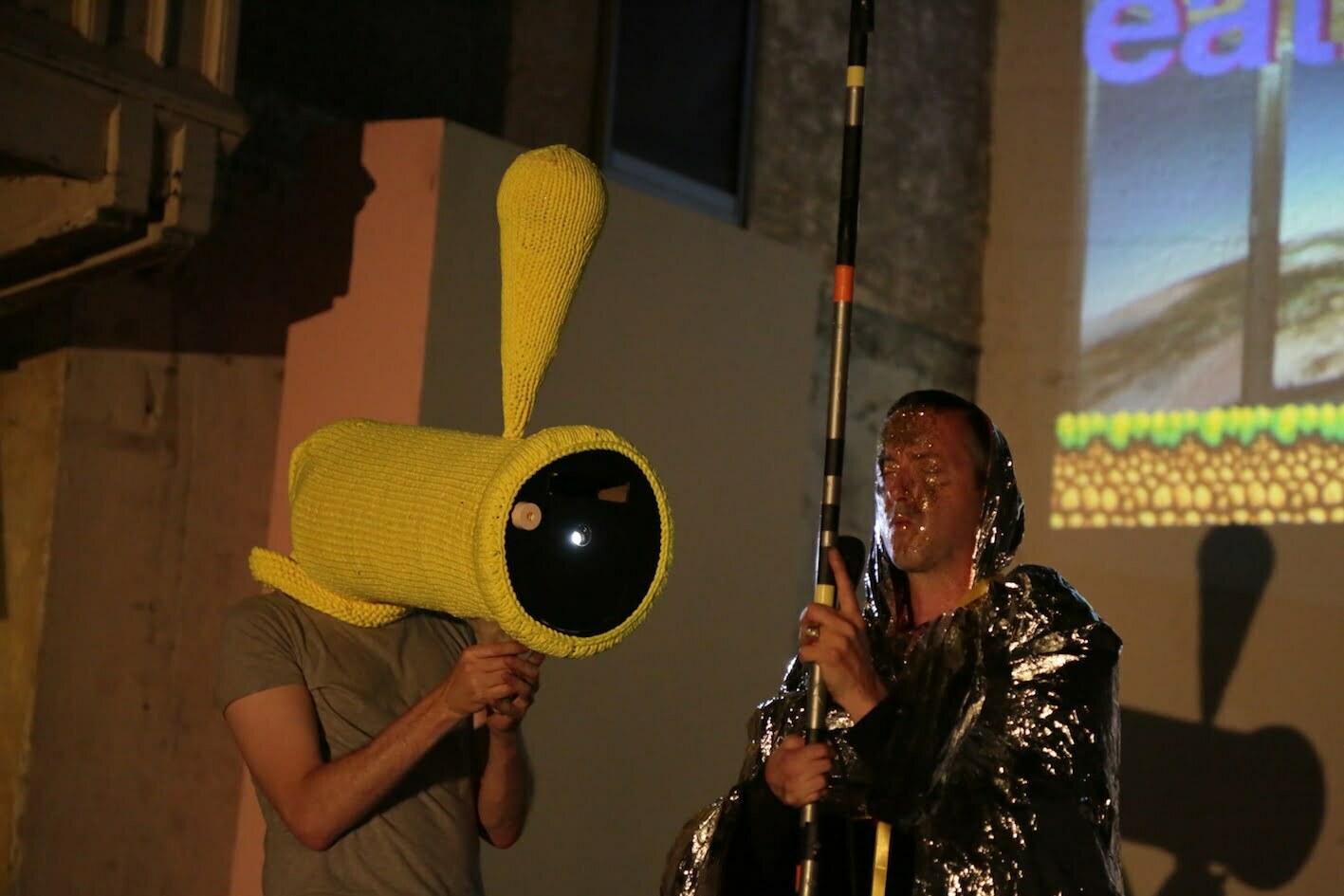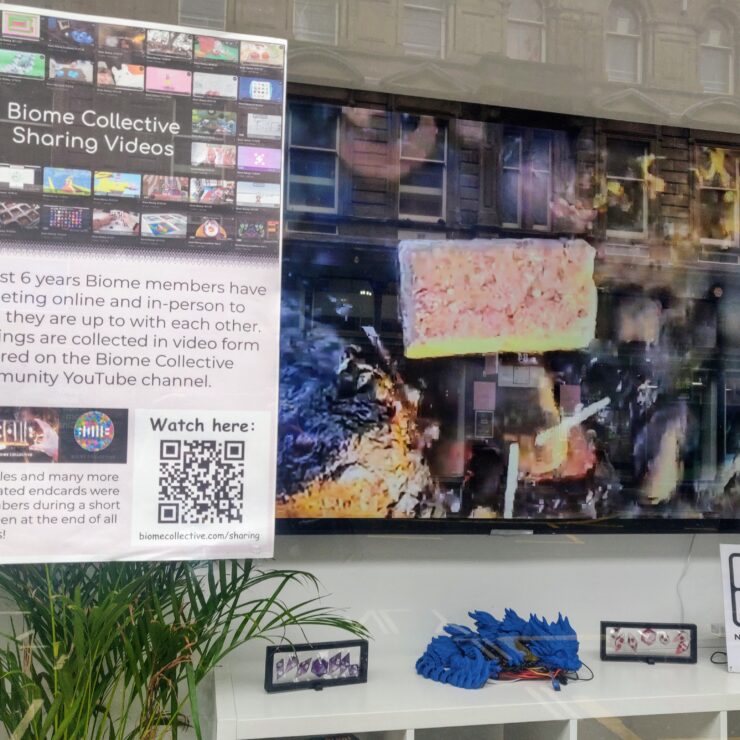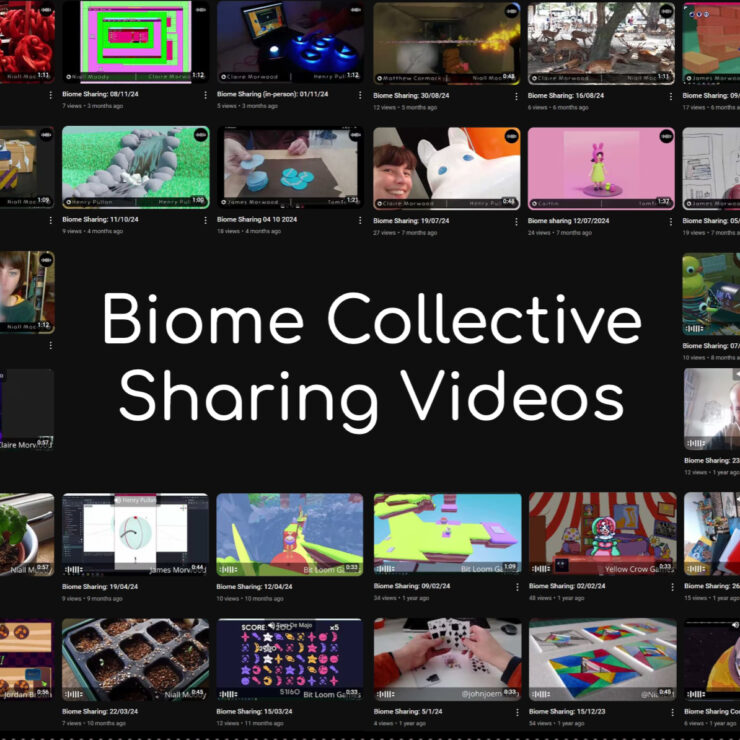Plastique Fantastique talk about performance and the bit-coin-fairy

Ahead of this year’s digital arts festival we caught up with performance group Plastique Fantastique to discuss collaboration, communication, and cardboard masks. Answers by David Burrows, with help from Simon O’Sullivan, Alex Marzeta and Vanessa Page.
What attracts you to performance, as an art form?
As well as being a good way to collaborate, performance, on one level, involves becoming an object, at least as an artwork or as the object of other people’s attention. We are attracted to being objects or things or parts of a machine for the duration of a performance, as a state that we return from. We are attracted to being avatars or even to becoming abject. We use a lot of objects, fluids, glitter, synths, loops, delays, mics and samples, and in a performance we are all one more aspect of this arrangement of things.

We do not know what our performances are like for spectators, good, bad, or whatever, and that lack of distance, which is a feature of performance, attracts us. We do not have much distance on our performances as we never see them, except maybe through documentation, but that is never the same thing as the performance itself. In other ways too, through performances, we have avatars we identify with and form friendships through that are important aspects of our lives.
But what really interests us is that performance allows for transformation, in that time, our bodies and thoughts can seem transformed by performance in which we become different avatars as impersonal vehicles for ideas and experiments and stories. Ultimately we present fictions, though not necessarily in conventional form. We call such works performance fictions. Our concern is to present the communiqués we receive from channeling information such as news, scientific papers, financial reports, promotions of digital technology, the weather, animal sounds, internet searches, tarot card readings, junk mail and spam and the suggestions we receive from objects and things.
We also diagram new mineral-animal-human-machine creatures and forces through intense or affective presentations, and we use our bodies to do this, as well as glitter, masks and fluids to mark transformations that are not visible. Intensity is what we hope for in a performance, and through intensity, to create after-images of new entities, for ourselves, and anyone that attends to our work. We follow protocols that we arrive at collectively, and that guide our actions. In this, we do not act spontaneously but we are not unlike medieval mummers that might turn up uninvited and make a lot of noise.

Do you find that installations suggest their own performances, or do the installations develop from the performances?
Communications from elsewhere comes first, which we gather and channel, then through talking and developing a performance involving music and gestures, we begin to see images. At a certain point a fiction emerges that might be our understanding of the evolution of a technology as machine-animal creature and avatar, or we try and convey a message or narrative that we often only half understand. Then we make objects and projections for this purpose.
For example, we knew recently that we had to do something concerning memes, particularly digital memes circulating through Instagram that we understand as a viral form existing only to replicate and reproduce, human-smart-phone creatures being the hosts. Through using tarot cards we realised that the hanged man was a kind of traitor meme, quite a rare thing, which doesn’t seek just replication through its host, but transformation or even the demise of its human host. For turning over the hanged man is a call for sacrifice and to see the world another way or upside down, but also, depending on which way up it turns, a call to defy gravity, and so we began to look for traitor memes in culture at large and put them on Instagram. It wasn’t until we heard ‘Traitor’ by Motorhead and then could not get Lemmy’s face, warts and all, out of our head that we began work on a traitor meme drone song, and then we made large images of hanging figures. To do this, we photographed and filmed ourselves hung upside down to form part of the images for the new ‘Traitor Memes’.
Can you tell us a bit about the masks and headpieces that you tend to wear during your performances, do you make them yourself and what inspires them?
Yes we make all of them ourselves. Again, we start through channeling or synthesising things we see or read about. For example, BI-SON-OIL-MAN, a figure that appeared in our performances in Aberdeen and London last year and this year, emerged fully formed, in all our heads, at Edinburgh airport when we were coming back from a performance at Jupitar Artland. Alex was reading about bison cattle being bred in Aberdeen, where we were due to show and perform later in the year. At the same time that Alex was showing us the share prices in bison stock, an oilman walked past lamenting the state of the oil industry and the need to find a new way of living. This made us think about how cattle and oil, being old and new forms of wealth or capital, at least for the UK, could be connected in some way in the future. We saw that one possibility was the ‘breeding’ of the two industries, to produce a BI-SON-OIL-MAN. This is what we attempted to communicate to people who came to our Aberdeen performance. To call forth this avatar we needed a mask, which Vanessa made out cardboard, mop fibres and plastic, and then Alex, Simon and I covered it in oil and black glitter in a ritual performance.

What is a ‘patheme-matheme assemblage’?
This is technical sounding and theoretical term that is really our shorthand phrase for an assemblage or performance that presents a combination of mathematical and animal knowledge. A patheme-matheme assemblage is the combination of the affective/the creaturely/the organic or animal-like with the mathematical/reason/machines (including automated and intelligent machines). A matheme is a lesson concerning structure, and it is a term used to describe formulas in science and maths. Patheme or the pathemic often refers to joy, pain or suffering. For us though, patheme is a word for a different kind of knowledge to that of the mathematical kind, registered through affects and often non-conscious and embodied adaptation to environments and technological arrangements. The term patheme for us might equate to knowledge of the effects of structures and the forces and speeds of mathematical/reason/machines.
What is the ‘high frequency trading animal’, and how does it differ from the ‘bit con fairy’ in your wider mythos?
One of our interests is in new technological developments that are virtual or digital, and that have invisibility for humans and the myths that develop from this new state of affairs. An obvious example is the idea and myth of the Cloud, which might indicate how humans on the whole find representing and understanding abstract, non-human and numerical aspects of technology and society difficult. We are interested in technologies that have virtual, disembodied and or immaterial processes that are represented by images, sounds, myths that are often contrasting with their material support, such as inorganic or electrical objects.
The hi-frequency-trading animal is the programme that allows millisecond fast trading to take place – quicker than the human eye blinks – to achieve an accumulation of small profits. The speed facilitated by the programme has advantages over human trading, and allows wealth to accrue gradually through small gains. A humans is no match for this kind of trader. The programmes are housed in computers in large protected hubs with high security, which is the material aspect of the animal perhaps, and hidden away in discrete complexes. The hi-frequency-trading animal is a new force on the planet, its actions are carried out at high speed but not in physical space. We conjure the animal as a four-legged beast with a suction hose that extends from its stomach. When it appears, we generally feed it glitter, which it eats up, as it has a vacuum cleaner for a stomach, but in its non-material state it hoovers up money in digital form.
The bit-coin-fairy is similarly a new, invisible force, which is composed of a block chain that resides in computers. For this reason it is never in one place. This Fairy, although invisible, eats electricity to the point where some say its appetite can outweigh its value. And it seems to us that the block chain is a fairy rather than an animal as its existence owes much to whether people believe in bit coin or not, and whether people believe crypto currency allows humans to exit the banking system and facilitate new social exchanges or whether it is just another form of control or like the ‘tulip bulb bubble’ of 17th century, just another speculative market. We felt it important to trap the Fairy in one place and ask it about what it is. We have summoned the Fairy twice, in a wood in Edinburgh and a converted church in London, to ask it questions.
These two avatars are similar in our mythos as they are new forces that affect the world but are invisible, however the hi-frequency-trader is a working animal whereas the bit-coin-fairy is more like a fever, a fairy-fever.

How did you and Simon O’Sullivan initially begin to collaborate and what do you think makes your collaboration work?
I asked Simon to write an essay for a catalogue for a show I was making. He refused but said that he would write a manifesto for the imaginary collective making my work. Then we wrote a comic about plastqiue fantastique and not soon after worked with a group of people who manifested the collective through performing as avatars, including Alex Marzeta and Vanessa Page. Together, Alex, Simon, Vanessa and I form the core group and we have worked with a lot of different people including Simon Davenport, Joe Murray, Stuart Tait, Ana Benlloch, and more recently Harriet Skully, Lawrence Leaman, Motsonian and Mark Jackson. We don’t think about why it works, or in fact whether it works, but it might be that it does work for those taking part as people like performing, making videos and objects and playing music, and people do what they want in the collaboration. None of us has a lot of time as we all work for a living, so together we can make something we can’t manage on our own. Maybe that is part of why it might work too.
Can you tell us a bit about ‘Mythopoesis–Myth-Science–Mythotechnesis: Fictioning and the Posthuman in Contemporary Art’, the volume of writings you are making with Simon?
The title will change I think, but we are writing a book about fiction in art and culture and politics. We address fiction as a verb though, and use the term fictioning throughout, which is the idea that fictions have a traction on reality, society or what is possible, rather than just the idea that something is made up and imaginary but has nothing to do with what actual does and will exist. We see science-fiction in this as important, being a loop between desires or fears for future and the present. Mythopoesis is a term for conjuring or manifesting worlds, myth-science relates to the musician Sun Ra’s alien perspectives and mythotechnesis concerns myths and narratives affecting human-machine/technology relations and development. The book will be published by Edinburgh University Press next year.

Is it sometimes your intention to confuse your audience?
We intend nothing when performing except to follow protocols and produce intense durations for ourselves, and others attending the performance, and to produce imagery and sonic encounters. In this, we hope to present the communiqués we receive. But in channeling communications from the past or future, and from virtual, cyber and digital and even alien entities including numbers and patterns, and also fleshy animals and plant and mineral forms, we are not always able translate the communications well or in a form that humans can understand. We can end up producing visual and sonic noise sometimes, which is composed of multiple signals, and which new machines might process easily but human senses, often conditioned by aesthetic habits, find difficult. We hope that any audience we have will adapt and evolve to receive our communiqués.
Do you consider your work to be archaeological, in terms of reimagining or repurposing memes or pop culture phenomena that might otherwise be lost?
Yes, we think of our practice as being concerned with media archaeology and media evolution or what might be better termed coadaptation of humans and machines and media. We know of the term media archaeology from the book ‘Deep Time of the Media’ by Zielinski, that tracks desire in techniques of seeing and hearing, and the book’s challenge to standard histories of media and progress. So the idea of the Deep Time of Media interests us, as does the idea of thinking all possible genealogies of media, or all possible forms of technologies, from human and animal bodies to silicon and chemical and machinic entities. We think this has something to do with the future of the human if it has one. We also know of media archaeology through Jussi Parikka’s work and his materialist take on media. Obsolescence too is an interesting idea. That said, when channeling, as we are rarely conscious, we cannot always tell what is past, present and future, or new or obsolete.
What are you particularly looking forward to about NEoN 2017?
We are looking forward to seeing the work of Verity Birt (who we have exhibited with in the past) and Morehshin Allahyari at NEoN 2017, and, as we will be performing with the intention of summoning a crypto-currency avatar, we are looking forward to trapping the Bit-Coin-Fairy again.
By Ana Hine


